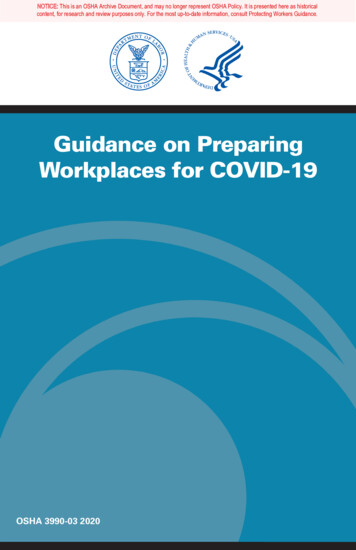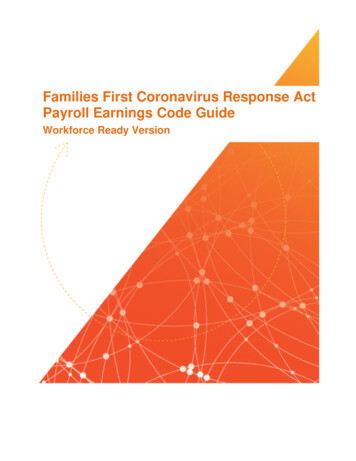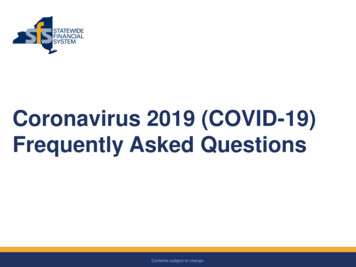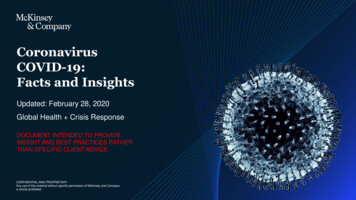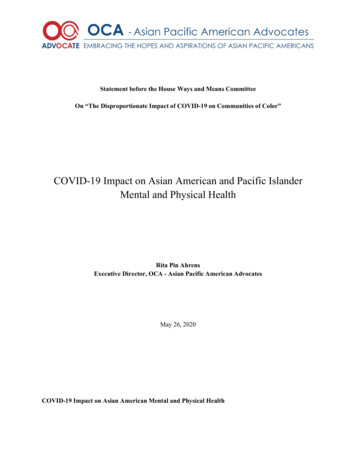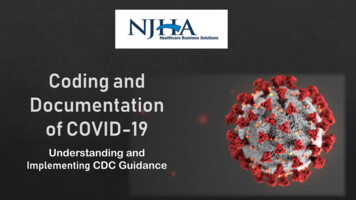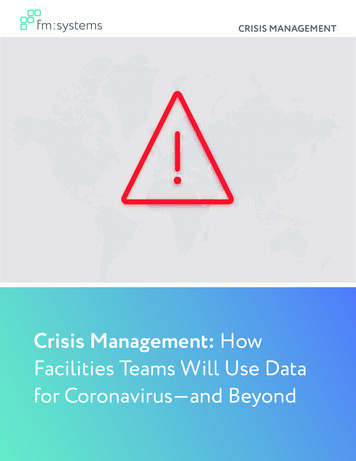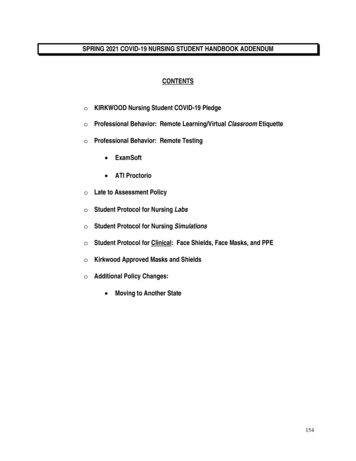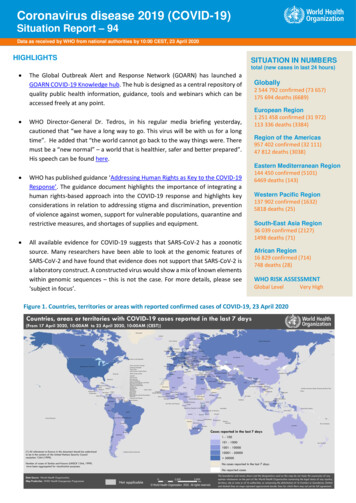
Transcription
Coronavirus disease 2019 (COVID-19)Situation Report – 94Data as received by WHO from national authorities by 10:00 CEST, 23 April 2020HIGHLIGHTSSITUATION IN NUMBERStotal (new cases in last 24 hours) The Global Outbreak Alert and Response Network (GOARN) has launched aGOARN COVID-19 Knowledge hub. The hub is designed as a central repository ofquality public health information, guidance, tools and webinars which can beaccessed freely at any point.WHO Director-General Dr. Tedros, in his regular media briefing yesterday,cautioned that “we have a long way to go. This virus will be with us for a longtime”. He added that “the world cannot go back to the way things were. Theremust be a “new normal” – a world that is healthier, safer and better prepared”.His speech can be found here.WHO has published guidance ‘Addressing Human Rights as Key to the COVID-19Response’. The guidance document highlights the importance of integrating ahuman rights-based approach into the COVID-19 response and highlights keyconsiderations in relation to addressing stigma and discrimination, preventionof violence against women, support for vulnerable populations, quarantine andrestrictive measures, and shortages of supplies and equipment.All available evidence for COVID-19 suggests that SARS-CoV-2 has a zoonoticsource. Many researchers have been able to look at the genomic features ofSARS-CoV-2 and have found that evidence does not support that SARS-CoV-2 isa laboratory construct. A constructed virus would show a mix of known elementswithin genomic sequences – this is not the case. For more details, please see‘subject in focus’.Globally2 544 792 confirmed (73 657)175 694 deaths (6689)European Region1 251 458 confirmed (31 972)113 336 deaths (3384)Region of the Americas957 402 confirmed (32 111)47 812 deaths (3038)Eastern Mediterranean Region144 450 confirmed (5101)6469 deaths (143)Western Pacific Region137 902 confirmed (1632)5818 deaths (25)South-East Asia Region36 039 confirmed (2127)1498 deaths (71)African Region16 829 confirmed (714)748 deaths (28)WHO RISK ASSESSMENTGlobal LevelFigure 1. Countries, territories or areas with reported confirmed cases of COVID-19, 23 April 2020Very High
SUBJECT IN FOCUS: Origin of the severe acute respiratory syndrome coronavirus-2(SARS-CoV-2), the virus causing COVID-19The first human cases of COVID-19, the disease caused by the novel coronavirus causing COVID-19, subsequentlynamed SARS-CoV-2 were first reported by officials in Wuhan City, China, in December 2019. Retrospectiveinvestigations by Chinese authorities have identified human cases with onset of symptoms in early December 2019.While some of the earliest known cases had a link to a wholesale food market in Wuhan, some did not. Many of theinitial patients were either stall owners, market employees, or regular visitors to this market. Environmental samplestaken from this market in December 2019 tested positive for SARS-CoV-2, further suggesting that the market inWuhan City was the source of this outbreak or played a role in the initial amplification of the outbreak. The marketwas closed on 1 January 2020.SARS-CoV-2 was identified in early January and its genetic sequence shared publicly on 11-12 January. The fullgenetic sequence of SARS-CoV-2 from the early human cases and the sequences of many other virus isolated fromhuman cases from China and all over the world since then show that SARS-CoV-2 has an ecological origin in batpopulations. All available evidence to date suggests that the virus has a natural animal origin and is not amanipulated or constructed virus. Many researchers have been able to look at the genomic features of SARS-CoV-2and have found that evidence does not support that SARS-CoV-2 is a laboratory construct. If it were a constructedvirus, its genomic sequence would show a mix of known elements. This is not the case.Another coronavirus, SARS-CoV-1, the cause of the Severe Acute Respiratory Syndrome (SARS) outbreak in 2003, wasalso closely related to other coronaviruses isolated from bats. These close genetic relations of SARS-CoV-1, SARSCoV-2 and other coronaviruses, suggest that they all have their ecological origin in bat populations. Many of thesecoronaviruses can also infect several animal species. For example, SARS-CoV-1 infected civet cats and then humans,while the virus causing the Middle East Respiratory Syndrome (MERS-CoV) is found in dromedary camels, and hascontinued to infect humans since 2012.All available evidence for COVID-19 suggests that SARS-CoV-2 has a zoonotic source. Since there is usually limitedclose contact between humans and bats, it is more likely that transmission of the virus to humans happened throughanother animal species, one that is more likely to be handled by humans. This intermediate animal host or zoonoticsource could be a domestic animal, a wild animal, or a domesticated wild animal and, as of yet, has not beenidentified.All the published genetic sequences of SARS-CoV-2 isolated from human cases are very similar. This suggests that thestart of the outbreak resulted from a single point introduction in the human population around the time that thevirus was first reported in humans in Wuhan, China in December 2019.A number of investigations to better understand the source of the outbreak in China are currently underway orplanned, including investigations of human cases with symptom onset in and around Wuhan in late 2019,environmental sampling from markets and farms in areas where the first human cases were identified, and detailedrecords on the source and type of wildlife species and farmed animals sold in these markets.Results from these studies are essential to preventing further zoonotic introductions of SARS-CoV-2 into the humanpopulation. WHO continues to collaborate with animal health and human health experts, Member States, and otherpartners to identify gaps and research priorities for the control of COVID-19, including the eventual identification ofthe source of the virus in China.
SURVEILLANCETable 1. Countries, territories or areas with reported laboratory-confirmed COVID-19 cases and deaths. Data as of23 April 2020*Reporting alconfirmednew cation§Days since lastreported 2190120000Clusters of casesClusters of casesClusters of casesClusters of casesClusters of casesClusters of casesClusters of casesClusters of casesClusters of casesSporadic casesSporadic casesSporadic cases000000016311019188001000000Sporadic casesSporadic casesSporadic cases10201335718000500000Clusters of casesSporadic casesSporadic cases11120Western Pacific RegionChinaJapanRepublic of KoreaSingaporePhilippinesAustraliaMalaysiaNew ZealandViet NamBrunei DarussalamCambodiaMongoliaLao People'sDemocratic RepublicFijiPapua New GuineaTerritories**GuamFrench PolynesiaNew CaledoniaNorthern MarianaIslands(Commonwealth ofthe)European 7327337025085437Germany14804623525094215The United urkeyRussian ionCommunitytransmissionClusters of casesCommunitytransmission0000000
057818713CzechiaSerbiaFinlandLuxembourgRepublic of AzerbaijanArmeniaLithuaniaBosnia 744202438011000136727522SloveniaNorth iaKyrgyzstan724634631101937278011San missionPendingPendingPendingPendingPendingClusters of casesPendingPendingCommunitytransmissionClusters of casesPendingClusters of casesClusters of sionClusters of casesClusters of casesPendingClusters of casesPendingCommunitytransmissionClusters of 000000000000000000000000001000
GeorgiaMontenegroLiechtensteinMonacoHoly oIsle of ManJersey6303072552605181014000GuernseyFaroe IslandsGibraltarGreenlandSouth-East Asia ndonesia7418Bangladesh3772Thailand2839Sri utan7Eastern Mediterranean RegionIran (Islamic Republicof)85996Saudi Arabia12772Pakistan10513United Arab 260CommunitytransmissionClusters of casesPendingSporadic casesSporadic ransmissionPendingClusters of casesPendingClusters of casesCommunitytransmissionPendingPendingClusters of casesClusters of casesClusters of casesSporadic casesClusters of casesSporadic casesCommunitytransmissionClusters of casesClusters of casesPendingPendingClusters of casesClusters of casesClusters of casesClusters of casesClusters of casesClusters of casesClusters of casesClusters of casesCommunitytransmissionClusters of casesClusters of casesSporadic casesSporadic casesClusters of cases004920100351700000000200000000000000010100
s of can 721967ArgentinaCubaCosta RicaBolivia (PlurinationalState of)UruguayHondurasGuatemalaVenezuela (BolivarianRepublic of)El nCommunitytransmissionClusters of casesClusters of cases609543510316118162237124683200Clusters of casesClusters of casesClusters of casesClusters of cases0000288237233312101076000000ParaguayTrinidad and TobagoBarbadosGuyanaBahamasHaitiAntigua and BarbudaBelizeDominicaSaint Kitts and NevisSaint 985794320000100001000000Clusters of casesClusters of casesClusters of casesCommunitytransmissionSporadic casesClusters of casesClusters of casesClusters of casesClusters of casesClusters of casesSporadic casesClusters of casesSporadic casesSporadic casesClusters of casesSyrian Arab RepublicYemenTerritories**occupied PalestinianterritoryRegion of the AmericasUnited States ofAmerica1120000000000000000600008122111
Saint Vincent and theGrenadinesNicaraguaSurinameTerritories**Puerto RicoMartiniqueGuadeloupeArubaBermudaFrench GuianaSint MaartenCayman IslandsUnited States VirginIslandsSaint MartinCuraçaoFalkland Islands(Malvinas)MontserratTurks and CaicosIslandsSaint BarthelemyBonaire, Sint Eustatiusand SabaBritish Virgin IslandsAnguillaSaint Pierre andMiquelonAfrican Region131010100021000Sporadic casesPendingSporadic 100000010Clusters of casesClusters of casesClusters of casesClusters of casesClusters of casesClusters of casesClusters of casesClusters of cases10300201543814010321000Clusters of casesSporadic casesSporadic cases10141211100000Clusters of casesSporadic cases09116001000Sporadic casesSporadic cases623543000010000Sporadic casesSporadic casesSporadic cases53191000Sporadic cases15South Africa3635170657AlgeriaCameroonGhanaCôte eaNiger76166273562202Burkina Faso60019380NigeriaSenegalDemocratic Republicof the missionClusters of casesClusters of casesClusters of casesCommunitytransmissionClusters of sters of casesClusters of casesCommunitytransmissionClusters of casesClusters of cases00200000301000
United Republic aTogoEquatorial GuineaZambiaCabo VerdeSierra EswatiniZimbabweAngolaMalawiBotswanaNamibiaCentral �o Tomé andPríncipeSouth SudanTerritories**RéunionMayotteSubtotal for allRegionsInternationalconveyance (DiamondPrincess)Grand 11010000142310000000001001000000010100Clusters of casesClusters of casesClusters of casesClusters of casesClusters of casesClusters of casesClusters of casesClusters of casesClusters of casesSporadic casesSporadic casesClusters of casesSporadic casesSporadic casesSporadic casesSporadic casesSporadic casesSporadic casesSporadic casesSporadic casesSporadic casesSporadic casesSporadic casesSporadic 0000Sporadic casesSporadic casesSporadic casesSporadic casesSporadic cases111621274300000Sporadic casesSporadic cases0114103260150400Clusters of casesClusters of cases1025440807365717568166897120130Not Applicable††382544792736571756946689Numbers include both domestic and repatriated cases†The designations employed and the presentation of the material in this publication do not imply the expression of any opinion whatsoever onthe part of WHO concerning the legal status of any country, territory, city or area or of its authorities, or concerning the delimitation of itsfrontiers or boundaries. Dotted and dashed lines on maps represent approximate border lines for which there may not yet be full agreement.‡Case classifications are based on WHO case definitions for COVID-19.§Transmission classification is based on a process of country/territory/area self-reporting. Classifications are reviewed on a weekly basis and maybe upgraded or downgraded as new information becomes available. Not all locations within a given country/territory/area are equally affected;countries/territories/areas experiencing multiple types of transmission are classified in the highest category reported. Within a giventransmission category, different countries/territories/areas may have differing degrees of transmission as indicated by the differing numbers ofcases, recency of cases, and other factors.
Terms:- No cases: Countries/territories/areas with no confirmed cases (not shown in table)- Sporadic cases: Countries/territories/areas with one or more cases, imported or locally detected- Clusters of cases: Countries/territories/areas experiencing cases, clustered in time, geographic location and/or by common exposures- Community transmission: Countries/area/territories experiencing larger outbreaks of local transmission defined through an assessment offactors including, but not limited to:- Large numbers of cases not linkable to transmission chains- Large numbers of cases from sentinel lab surveillance- Multiple unrelated clusters in several areas of the country/territory/area** “Territories” include territories, areas, overseas dependencies and other jurisdictions of similar status[1] All references to Kosovo should be understood to be in the context of the United Nations Security Council resolution 1244 (1999).†† As the international conveyance (Diamond Princess) is no longer occupied, transmission classification cannot be applied.Due to differences in reporting methods, retrospective data consolidation, and reporting delays, the number of new cases may not alwaysreflect the exact difference between yesterday’s and today’s totals. WHO COVID-19 Situation Reports present official counts of confirmedCOVID-19 cases, thus differences between WHO reports and other sources of COVID-19 data using different inclusion criteria and differentdata cutoff times are to be expected.Figure 4. Epidemic curve of confirmed COVID-19, by date of report and WHO region through 23 April 2020
STRATEGIC OBJECTIVESWHO’s strategic objectives for this response are to: Interrupt human-to-human transmission including reducing secondary infections among close contactsand health care workers, preventing transmission amplification events, and preventing furtherinternational spread*;Identify, isolate and care for patients early, including providing optimized care for infected patients;Identify and reduce transmission from the animal source;Address crucial unknowns regarding clinical severity, extent of transmission and infection, treatmentoptions, and accelerate the development of diagnostics, therapeutics and vaccines;Communicate critical risk and event information to all communities and counter misinformation;Minimize social and economic impact through multisectoral partnerships.*This can be achieved through a combination of public health measures, such as rapid identification, diagnosisand management of the cases, identification and follow up of the contacts, infection prevention and control inhealth care settings, implementation of health measures for travelers, awareness-raising in the population andrisk communication.PREPAREDNESS AND RESPONSE To view all technical guidance documents regarding COVID-19, please go to this webpage.WHO has developed interim guidance for laboratory diagnosis, advice on the use of masks during home care andin health care settings in the context of COVID-19 outbreak, clinical management, infection prevention andcontrol in health care settings, home care for patients with suspected novel coronavirus, risk communication andcommunity engagement and Global Surveillance for human infection with COVID-19.WHO is working closely with International Air Transport Association (IATA) and have jointly developed aguidance document to provide advice to cabin crew and airport workers, based on country queries. Theguidance can be found on the IATA webpage.WHO has been in regular and direct contact with Member States where cases have been reported. WHO is alsoinforming other countries about the situation and providing support as requested.WHO is working with its networks of researchers and other experts to coordinate global work on surveillance,epidemiology, mathematical modelling, diagnostics and virology, clinical care and treatment, infectionprevention and control, and risk communication. WHO has issued interim guidance for countries, which areupdated regularly.WHO has prepared a disease commodity package that includes an essential list of biomedical equipment,medicines and supplies necessary to care for patients with COVID-19.WHO has provided recommendations to reduce risk of transmission from animals to humans.WHO has published an updated recommendations for international traffic in relation to COVID-19 outbreak .WHO has activated the R&D blueprint to accelerate diagnostics, vaccines, and therapeutics.OpenWHO is an interactive, web-based, knowledge-transfer platform offering online courses to improve theresponse to health emergencies. COVID-19 courses can be found here and courses in additional nationallanguages here. Specifically, WHO has developed online courses on the following topics:o Introduction to Go.Data – Field data collection, chains of transmission and contact follow-up. TheGo.Data tool is available globally to WHO staff, member states and partners to support outbreakinvestigation, focusing on field data collection, contact tracing and visualisation of chains oftransmission.
o A general introduction to emerging respiratory viruses, including novel coronaviruses (available inArabic, Chinese, English, French, Russian, Spanish, Hindi, Indian Sign Language, Persian, Portuguese,Serbian and Turkish);o Clinical care for Severe Acute Respiratory Infections (available in English, French, Russian, Indonesianand Vietnamese);o Health and safety briefing for respiratory diseases - ePROTECT (available in Chinese, English, French,Russian, Spanish, Indonesian and Portuguese);o Infection Prevention and Control for Novel Coronavirus (COVID-19) (available in Chinese, English, French,Russian, Spanish, Indonesian, Italian, Japanese, Portuguese and Serbian); ando COVID-19 Operational Planning Guidelines and COVID-19 Partners Platform to support countrypreparedness and response (available in English and coming soon in additional languages).WHO is providing guidance on early investigations, which are critical in an outbreak of a new virus. The datacollected from the protocols can be used to refine recommendations for surveillance and case definitions, tocharacterize the key epidemiological transmission features of COVID-19, help understand spread, severity,spectrum of disease, impact on the community and to inform operational models for implementation ofcountermeasures such as case isolation, contact tracing and isolation. Several protocols are available here. Onesuch protocol is for the investigation of early COVID-19 cases and contacts (the “First Few X (FFX) Cases andcontact investigation protocol for 2019-novel coronavirus (2019-nCoV) infection”). The protocol is designed togain an early understanding of the key clinical, epidemiological and virological characteristics of the first cases ofCOVID-19 infection detected in any individual country, to inform the development and updating of public healthguidance to manage cases and reduce the potential spread and impact of infection.RECOMMENDATIONS AND ADVICE FOR THE PUBLICIf you are not in an area where COVID-19 is spreading or have not travelled from an area where COVID-19 isspreading or have not been in contact with an infected patient, your risk of infection is low. It is understandable thatyou may feel anxious about the outbreak. Get the facts from reliable sources to help you accurately determine yourrisks so that you can take reasonable precautions (see Frequently Asked Questions). Seek guidance from WHO, yourhealthcare provider, your national public health authority or your employer for accurate information on COVID-19and whether COVID-19 is circulating where you live. It is important to be informed of the situation and takeappropriate measures to protect yourself and your family (see Protection measures for everyone).If you are in an area where there are cases of COVID-19 you need to take the risk of infection seriously. Follow theadvice of WHO and guidance issued by national and local health authorities. For most people, COVID-19 infectionwill cause mild illness however, it can make some people very ill and, in some people, it can be fatal. Older people,and those with pre-existing medical conditions (such as cardiovascular disease, chronic respiratory disease ordiabetes) are at risk for severe disease (See Protection measures for persons who are in or have recently visited (past14 days) areas where COVID-19 is spreading).CASE DEFINITIONSWHO periodically updates the Global Surveillance for human infection with coronavirus disease (COVID-19)document which includes case definitions.For easy reference, case definitions are included below.Suspect caseA. A patient with acute respiratory illness (fever and at least one sign/symptom of respiratory disease, e.g., cough,shortness of breath), AND a history of travel to or residence in a location reporting community transmission of
COVID-19 disease during the 14 days prior to symptom onset.ORB. A patient with any acute respiratory illness AND having been in contact with a confirmed or probable COVID-19case (see definition of contact) in the last 14 days prior to symptom onset;ORC. A patient with severe acute respiratory illness (fever and at least one sign/symptom of respiratory disease, e.g.,cough, shortness of breath; AND requiring hospitalization) AND in the absence of an alternative diagnosis thatfully explains the clinical presentation.Probable caseA. A suspect case for whom testing for the COVID-19 virus is inconclusive.a. Inconclusive being the result of the test reported by the laboratory.ORB. A suspect case for whom testing could not be performed for any reason.Confirmed caseA person with laboratory confirmation of COVID-19 infection, irrespective of clinical signs and symptoms. Technical guidance for laboratory testing can be found here.Definition of contactA contact is a person who experienced any one of the following exposures during the 2 days before and the 14 daysafter the onset of symptoms of a probable or confirmed case:1. Face-to-face contact with a probable or confirmed case within 1 meter and for more than 15 minutes;2. Direct physical contact with a probable or confirmed case;3. Direct care for a patient with probable or confirmed COVID-19 disease without using proper personalprotective equipment1; OR4. Other situations as indicated by local risk assessments.Note: for confirmed asymptomatic cases, the period of contact is measured as the 2 days before through the 14 daysafter the date on which the sample was taken which led to confirmation.Definition of COVID-19 deathCOVID-19 death is defined for surveillance purposes as a death resulting from a clinically compatible illness in aprobable or confirmed COVID-19 case, unless there is a clear alternative cause of death that cannot be related toCOVID disease (e.g. trauma). There should be no period of complete recovery between the illness and death.Further guidance for certification and classification (coding) of COVID-19 as cause of death is available here.1World Health Organization. Infection prevention and control during health care when COVID-19 is ed-20200125
Apr 23, 2020 · human cases from China and all over the world since then show that SARS-CoV-2 has an ecological origin in bat populations. All available evidence to date suggests that the virus has a natural animal origin and is not a manipulated or constructed virus. Many researchers hav
